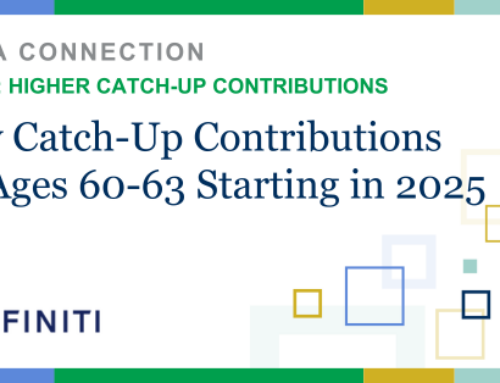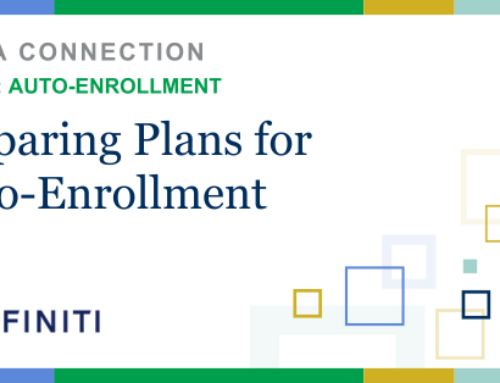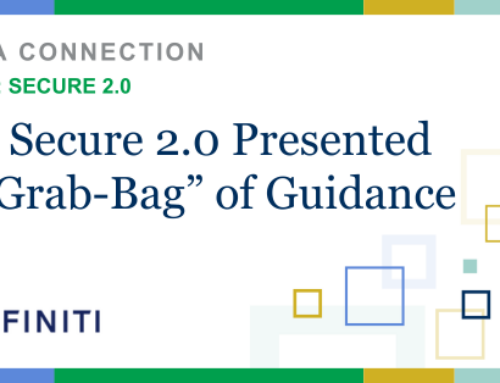SECURE 2.0 included 90+ provisions that could have an impact on your plan. Definiti has carefully reviewed all the provisions, and we’re making recommendations on how our portfolio of clients may want to amend their plan to adopt the new optional provisions.
On December 20, 2023, the IRS issued Notice 2024-2, a series of frequently asked questions on 12 SECURE 2.0 provisions. This means there are still more than 70 provisions for which no guidance has been provided. Keep in mind some provisions require more guidance before they are final, and many provisions won’t become effective until 2025, or later.
If your plan(s) services with Definiti includes the Document Maintenance Program, any discretionary or mandatory amendments are covered and Definiti will file the amendments for you when they are made available.
Contact your Definiti Retirement Plan Consultant (or RPC) to discuss any of these changes or any other SECURE 2.0 requirements.
SECTION 1
Mandatory Plan Document Provisions
§101
Mandatory Automatic Enrollment for “New” 401(k) Plans
One of the most significant changes in SECURE 2.0 is the requirement to include automatic enrollment. New plans (with some statutory exceptions) signed after December 29, 2022, are required to automatically enroll participants in the plan beginning in the 2025 plan year.
Automatic enrollment is a plan design in which once a participant meets the eligibility requirements and passes an entry date, they will be enrolled at the plan’s default enrollment rate.
This rate will be increased by 1% annually, up to 15%. Participants may stop or reduce deferrals at any time, and, under this arrangement, plans must provide a grace period (90 days from the first withholding) for a participant to be able to notify the plan and withdraw their funds. Once 90 days have passed, the plan’s distribution restrictions apply.
§603
Mandatory Roth Catch-Up Contributions
Catch-ups under a 401(k), 403(b) plan, or governmental 457(b) plan must be designated Roth contributions for participants with more than $145,000 (indexed) in wages in prior year, and participants earning less than $145,000 (indexed) in wages in prior year must have Roth option for catch ups.
SECTION 2
Optional Plan Document Provisions
Definiti has reviewed these plan provisions and has determined that they offer some benefit to plan sponsors and participants.
Because these provisions are optional, Plan Sponsors may elect to adopt something different than our default. To amend your plan document differently than our default decision, you can make elections here.
§109
Higher Catch-up Limits for Ages 60, 61, 62 and 63
This provision increases the catch-up contribution limit to the greater of $10,000 or 150% of the regular catch-up amount for the 2025 calendar year for Employees who have attained ages 60, 61, 62 and 63. After 2025, the increased catch-up contribution limit will be indexed for inflation.
§304
Increase in Dollar Limit for Mandatory Distributions
Effective for distributions made after December 31, 2023, unless elected otherwise below, the Involuntary Cash-Out Distribution threshold for a Plan that utilizes the $5,000 threshold is increased to $7,000. Unless elected otherwise below, a Plan that currently utilizes an Involuntary Cash-Out Distribution lower than $5,000 will continue to apply such lower threshold.
§312
Participant Self-Certification for Hardship Distributions
The Plan Administrator may, but is not required to, rely on a written certification by a Participant that a requested Hardship distribution is: (1) on account of a financial need of a type which is deemed to be an immediate and heavy financial need, and (2) not in excess of the amount necessary to satisfy such financial need, and (3) that the Participant has no alternative means reasonably available to satisfy such financial need.
If elected, this provision will allow a employee to self-certify that their distribution request qualifies as a hardship distribution and that the distribution is in compliance with most applicable rules and requirements. The employee must maintain all documentation related to the distribution. The employer (or designee) may not have knowledge to the contrary.
§331
Special Rules for Use of Retirement Funds in Connection with Qualified Federally Declared Disasters
For federally declared disasters occurring on or after January 26, 2021, the Plan allows up to $22,000 to be distributed from the affected individuals account. Such distributions are not subject to the 10% additional tax and are taken into account as gross income over 3 years. Distributions can be repaid to an eligible retirement plan.
SECTION 3
Other Plan Provisions
While the following optional provisions are included in the SECURE 2.0 legislation, Definiti has reviewed our plan demographics and do not find these provisions to be beneficial to our portfolio of plans. Plans may choose to adopt these provisions here if needed. Contact your Definiti Retirement Plan Consultant (or RPC) to discuss any of these changes or any other SECURE 2.0 requirements.
§110
Treatment of Student Loan Payments as Elective Deferrals for Matching Contributions
SECURE 2.0 allows for employers to match employees’ student loan repayments as if they were deferrals into the 401(k) plan, and the match for this purpose will be tested separately than the match on deferrals.
Any debt incurred by the employee solely to pay qualified higher education expenses of the employee. This provision may rely on employee certification.
The following optional provisions will not be adopted unless specifically elected. Contact your Definiti Retirement Plan Consultant (or RPC) to discuss these provisions in more detail.
§112 – Military Spouse Retirement Plan Credit
Provides small employers (100 employees or less) a tax credit if they: make military spouses immediately eligible for plan participation within two months of hire; make the military spouse eligible for any matching or nonelective contribution if they have been credited with 2 years of service; and make the military spouse 100% immediately vested
§115 – Withdrawals for Certain Emergency Expenses
Provides an exception for certain distributions used for emergency expenses, which are unforeseeable or immediate financial needs relating to personal or family emergency expenses.
§120 – Exemption for Certain Automatic Portability Transactions
When workers leave jobs with a retirement benefit valued at $7,000 or less, their savings plan can automatically rollover their benefits to a Safe Harbor IRA if the plan document allows it and the employee does not take action after receiving required notices. Auto-portability transactions involve automatically transferring workers’ retirement savings from their Safe Harbor IRA to their active account in a retirement plan sponsored by their new employer.
§127 – Pension-linked Emergency Savings Accounts (PLESAs)
PLESAs are a short-term savings account for emergency expenses tied to an existing 401(k), 403(b) or governmental 457(b) plan. Plan participants who are non-highly compensated and otherwise eligible to participate in the plan (i.e., meet the age, service, and entry requirements), may contribute to a PLESA.
§314 – Domestic Abuse Distributions
Allows for the withdrawal of up to the lesser of $10,000 (indexed) or 50% of the vested balance within one year of incident without penalty; allows plan administrators to rely on a participant’s certification that they are receiving an “eligible distribution to a domestic abuse victim”
§334 – Qualified Long-Term Care Distributions
Permits retirement plans to provide for distributions for the payment of premiums for certain specified Long-Term Care distributions. Such distributions are exempt from the additional 10% tax on early distributions



